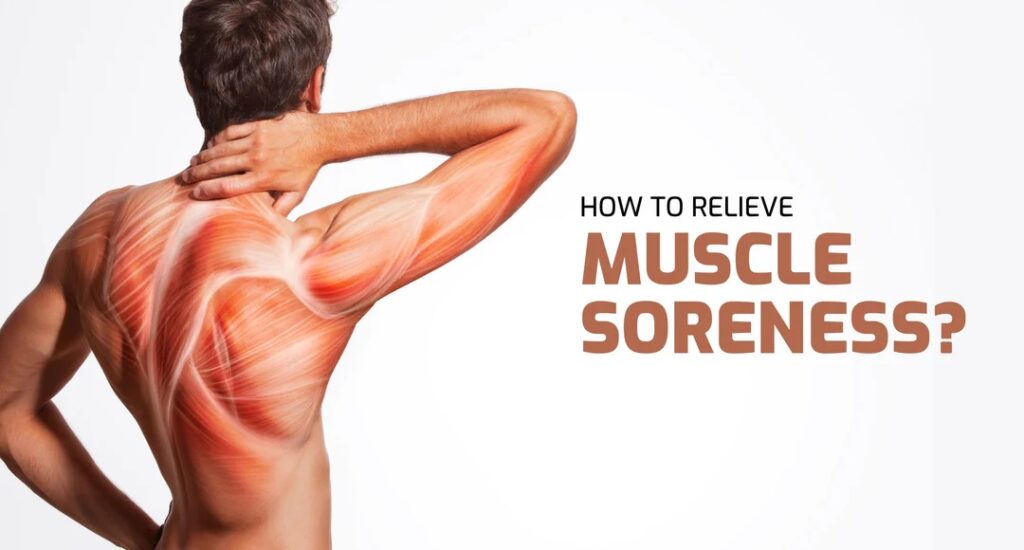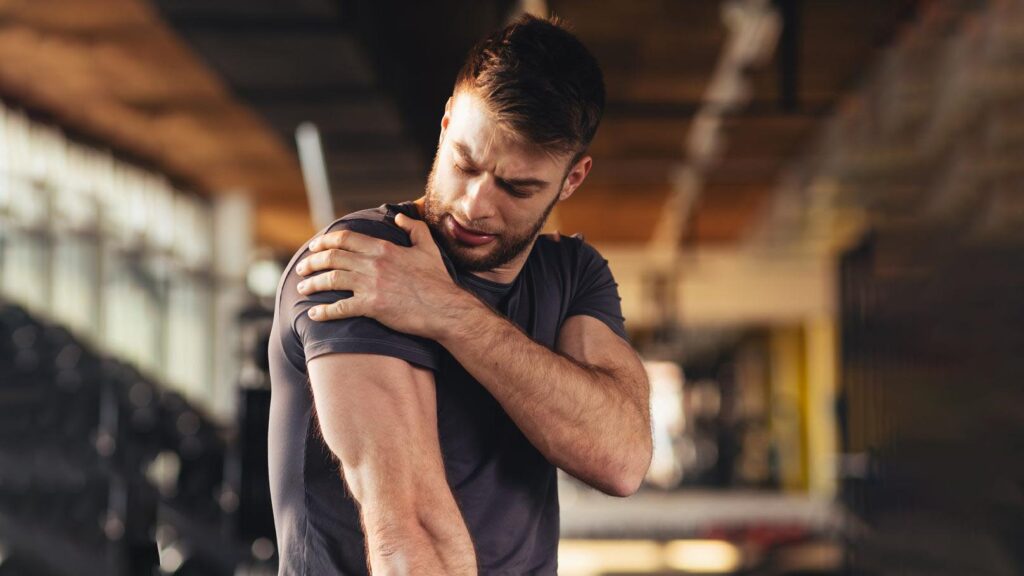Delayed Onset Muscle Soreness or in short, DOMS is a very common side-effect of working out. If you are just a beginner and started working out for a few days, you may have experienced the muscle pain within 12 to 24 hours after workout. This muscle pain or soreness is scientifically called Delayed Onset Muscle Soreness or DOMS. When you first experience this type of muscle pain, it is natural to get intimidated. That’s why we are here to clear all your clouds of confusions regarding this issue. Continue reading to know the answers of all your probable questions like: What are the causes of DOMS? Is it good or bad for muscle gain? What are the actual symptoms? How to reduce the pain? When can it be considered dangerous and when to see a doctor? Etc.
What is Delayed Onset Muscle Soreness (DOMS)?
First, it is important to know, what really is this muscle soreness that you feel several hours after your workout. When you first start to workout or change your workout routine, the muscles are not habituated with it so while working out, these muscles tear in the microscopic level and these tears cause a burning sensation and pain in the muscles. Actually, when the muscle fibers tear, your body increases the inflammation by responding that muscle damage. This ultimately leads to the muscle soreness and a deep burning sensation.This pain and burning sensation is known as Delayed Onset Muscle Soreness.

Symptoms of DOMS
The symptoms of Delayed Onset Muscle Soreness is pretty easy to identify. These are the few symptoms to watch out.
- Muscle pain at least 12 to 24 hours after workout.
- Muscle stiffness due to the tears in muscle fibers.
- Limited range of motion because of muscle stiffness and pain.
- Loss in muscle strength due to the pain.
- Muscle fatigue.
- Swelling in the damaged muscles.
- Muscles that feel tender when touching.
- Muscle pain gone after 72 hours or 3 days.
Keep in mind that DOMS only occurs up at least 12 to 24 hours after workout. If your muscles are sore during or just after workout that is not a sign of DOMS rather it is another type of muscle soreness which is called the acute muscle soreness. Acute muscle soreness stays for a few minutes on the muscle you workout and it is gone shortly after you finish your workout session. So, it is just a natural way or response by your muscles when you work out but DOMS is totally different than that as we mentioned already.
Reasons Why You Are Experiencing DOMS!
When it comes to experience Delayed Onset Muscle Soreness, not only beginners but also elite athletes can also experience that. There are very few reasons why you experience this muscle soreness and all these reasons lead to one conclusion that is, DOMS occurs when the muscles are not accustomed with the pressure. Let’s know all these reasons in detail.

- If you are a beginner and just started working out for a few days then you most likely face this muscle soreness because the muscles are now weak for lifting weights and are obviously not habituated with the exercises. That leads to the tears in microscopic level in your muscle fibers and it will cause muscle soreness.
- As we already said, even elite and advanced bodybuilders or athletes also face DOMS. How? When an athlete regardless of his experience and muscularity changes his/her workout programme, there is a chance that he/she will face this muscle soreness because of the same reason again. Yes, if the muscles may not get habituated in the new workout programme, they will tear and it will cause muscle soreness ultimately.
- If someone who didn’t workout for a long period of time and then start working out again, there is a high chance that person will experience DOMS because the muscles need time to adapt the pressure of lifting weights again.
- There is also a chance of having DOMS if you suddenly push yourself harder. Let’s say, you deadlift 300lbs and then one day, you lift a few pounds more. It might cause lower back pain as your lower back muscles would become sore because again, they are not habituated for more than 300lbs. That’s why to prevent muscle soreness, an experienced gym-goer or athlete should follow progressive overload.
Don’t Miss: What is Progressive Overload? Why is it Necessary for Muscle Building?
So, you can now realise how this muscle pain happens. Anything you perform in the gym, if it pushes your muscles from their comfort zone, they will tear in a microscopic level and you will experience the pain and inflammation. However, mostly beginners experience DOMS because their muscles are not accustomed to lift weights at all and the chance of getting injured is really high for them.
Is DOMS Good Or Bad?!
Delayed Onset Muscle Soreness is not a bad thing at all. It is just a common and minor side-effects when you start working out as a beginner or change your workout programme or push yourself more than previous days. DOMS goes away naturally within 3 days or 72 hours and it is better not to train that muscle group that is experiencing that muscle soreness until it goes away. Everyone faces DOMS in some stages of their fitness journey and it will go away eventually. You will feel less and less sore with each workout and within a few weeks, the muscle soreness should not be felt at all because your body would have adapted that muscle damages caused by the workouts.

What Effects Does DOMS Has on Muscle Gain?
Short answer, there is no effect Delayed Onset Muscle Soreness has on muscle gain. It is just your body increases the inflammation in response to those muscle tears but as we discussed earlier, it will eventually go away and your body will no longer response to these damages because they get habituated. This brings an interesting part.
Also Read: Biggest Fitness Myths That You Should Avoid Immediately!

There is a popular myth that is easily known by this quote: “No Pain, No Gain!” it sounds cool but is it what you need to do for muscle gain? No! Rather if you push yourself over and over in the gym by lifting unnecessary weights to get more muscle pain than you will get injured yourself because of this overtraining. Healthy progressive overload is the way to build muscle faster. So, yes without pain, your muscle gain should be safer and better. Once your body adapts, you may not feel any pain or DOMS at all after workout but that doesn’t mean you don’t workout hard enough.
Tips to Ease The Pain
Delayed Onset Muscle Soreness stays for 72 hours only but it can be painful at first especially if you are not experienced with this kind of pain.Time is the best medicine for DOMS still there are certain things you can do to ease the pain.
- Don’t sit idle. Sitting or lying for a long time can make your muscles stiff and it can cause more pain when you start to move them so keep moving to prevent the stiffness and more inflammation. Walk, cycle, swim, stretch your body, stretch the muscles that are sore.
- Don’t workout the muscles that are sore until they are fully repaired. Working out the same muscle will worsen the pain and damage your muscles further that can lead you to injuries! So, make sure you are working out different muscles on different days.
- Eat clean diet with high protein and Omega-3 fatty acids. Fatty fishes, poultry, eggs are some of the common foods that are high in protein and Omega-3. Protein will recover your muscles’ damage to make them stronger so that you won’t get sore that much next time and Omega-3 will reduce the inflammation inside the muscles. This combination will easily reduce the pain and make your muscles stronger for next workout.
Don’t Miss: Top 5 Highest Protein Foods You Must Consume!

- Body massage is a great way to relax your muscles from inflammation and prevent the muscle stiffness. Getting a massage 24 to 48 hours after workout is the perfect way to ease your muscle pain. You can also use foam roller to help your muscles recover.
- Cold bath especially ice bath is great for recovering muscles. You may have seen competitive professional bodybuilders and athletes to have ice baths to recover their muscles. Yes, it is also great to reduce the burning sensation of muscles so you can try that if you are mentally strong enough.

- If cold bath or ice bath is too much for you, warm bath also seems good for muscle recovery but it can reduce the stiffness more than the pain and the burning sensation still it is helpful and you can try it.
Also Read: 10 Highest Omega-3 Foods That You Shouldn’t Avoid!
If you think your muscle soreness is too extreme and you can’t bear the pain than you should start eating anti-inflammatory foods like berries, green leafy vegetables, fatty fishes that are rich in Omega-3 etc. We already have mentioned that Omega-3 can reduce the inflammation of muscles so it is also a part of anti-inflammatory foods. With Omega-3 and protein, go for other anti-inflammatory foods to ease your muscle inflammation quickly.
When is DOMS Dangerous?!
Frankly speaking, in 95% cases, Delayed Onset Muscle Soreness is not dangerous at all because it goes away within 72 hours without any treatment but if your pain is in extreme level and it does not go away even after 7 days then it is time to seek a doctor or medical help. Very sharp and unbearable pain, numb and swollen muscles that goes dark or blue – these are not good signs at all and you need to see a doctor immediately. These can be severe muscle fiber tears and damages.

The Bottom Line
Delayed Onset Muscle Soreness or DOMS is body’s common way to respond when you do something with which your muscle fibers are not habituated. And that pain goes way within 72 hours. The more you make your muscles accustomed to the same routine, the less you will experience DOMS. You can somewhat prevent the amount of DOMS you will experience by doing warm up before workout, staying hydrated, following progressive overload and slowly increasing your intensity of the exercises.
This muscle soreness is not dangerous at all but it is not good too. It is just a body’s response and nothing else; neither good nor bad. Your muscles will still tear at the microscopic level but your body will stop responding by increasing the inflammation because it will adapt. Hope, we have covered all the queries regarding Delayed Onset Muscle Soreness and hope that we have cleared the clouds of confusions from your head. If you have found this article helpful enough, don’t forget to express your valuable thoughts in the comment section below. Thanks for visiting and appreciating our work.
